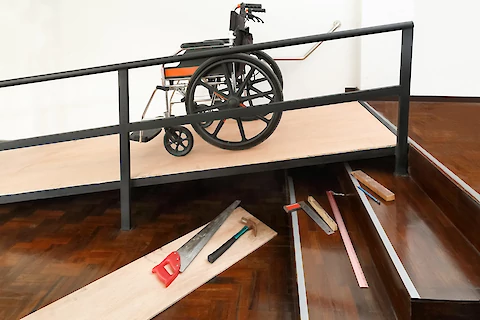
Setting up a temporary at-home wheelchair-accessible ramp for elderly family members can seem daunting. But with the proper preparation and supplies, anyone can do it. In this article, we'll provide some easy steps to install a safe and secure temporary ramp for seniors successfully.
Why Install a Ramp?
Installing a ramp at home is the best way to ensure that seniors can independently move about without risking a fall. Ramps eliminate tedious tasks like carrying someone up and down steps. Wheelchair-accessible ramps increase mobility and comfort within the home. It can also help family members move around while spending time with loved ones indoors or outdoors.
4 Steps for Installing a Temporary Ramp
Measure the height of the steps
Before purchasing any materials, measure the height of the steps from the ground level to the entry point. Use these measurements to draw out a plan, keeping the slope to 1:12. This ratio means there should be 12 inches of ramp for every inch of height. So for a height change of 10 inches, you'll need a ramp that's 120 inches long. This ratio will help you determine what type of ramp best suits your home and how much material is required.
Choose the right materials for the ramp
Next, you will need to choose the right materials for your ramp. The most popular choice is a wooden plank made from pressure-treated wood. You can purchase these at your local hardware store or lumber yard. However, depending on the height of the steps and the desired aesthetic, other options may include aluminum or steel grating. Ensure that whatever material you choose has non-slip properties. It must also be strong enough to withstand pressure from a wheelchair or walker user.
Assemble the ramp
Once you’ve gathered the materials, you can begin to assemble the ramp:
- Install footings on either side of the steps to help secure and support the ramp's weight.
- Add brackets at each end to provide additional stability and structure.
- Join your boards or pieces together. They'll need to be long enough for a wheelchair or walker user to go up and down safely.
Secure the ramp to the steps
Ensure you adequately secure the ramp to the steps and footing with lag bolts instead of nails for maximum stability. Once secure, use a carpenter's level to ensure the ramp's surface is even to reduce any slips or falls that may occur.
Bonus Tips for Installing a Ramp
When you install a temporary ramp, make sure it meets all safety requirements. Ensure the ramp's width is wide enough for wheelchairs and walkers. It should also be non-slip. And you'll want to connect each piece securely for maximum strength. If you have any questions or doubts about your ramp installation, contact a professional who can get your installation process off to a safe start.
Is Your Senior Loved One Experiencing Mobility Issues?
Safety should be your priority when installing a temporary wheelchair-accessible ramp in your home. Caregivers often think they can handle the challenging task of designing and constructing ramps. However, it's essential to seek professional advice whenever possible if you have any doubts about your ability to install a ramp on your own.
If you care for a senior relative in Cook County, IL, or Chicago and need additional help keeping them safe and cared for at home, contact Senior Helpers Chicago today. We provide you and your elderly loved ones with the peace of mind and comfort they need while aging in place.